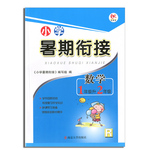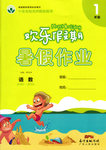题目内容
--- Did that book give the information you needed?
--- Yes, but ______, we had to read it almost entirely.
A. for finding it B. to find it C. finding it D. by finding it
B
解析:
此处的to find it, 表示目的。

 波波熊暑假作业江西人民出版社系列答案
波波熊暑假作业江西人民出版社系列答案 学而优暑期衔接南京大学出版社系列答案
学而优暑期衔接南京大学出版社系列答案 Happy holiday欢乐假期暑假作业广东人民出版社系列答案
Happy holiday欢乐假期暑假作业广东人民出版社系列答案THE BRONTE FAMILY
Yorkshire, England was the setting for two great novels (小说) of the 19th century. These were Charlotte Bronte’s Jane Eyre and Emily Bronte’s Wuthering Heights. The youngest sister, Anne, was also a gifted novelist, and her books have the same extraordinary quality as her sisters’.
Their father was Patrick Bronte, born in Ireland. He moved with his wife, Maria Bronte, and their six small children to Haworth in Yorkshire in 1820. Soon after, Mrs. Bronte and the two eldest children died, leaving the father to care of the remaining three girls and a boy.
Charlotte was born in 1816. Emily was born in 1818 and Anne in 1820. Their brother Branwell was born in 1817. Left to themselves, the children wrote and told stories and walked over the hills. They grew up largely self-educated. Branwell showed a great interest in drawing. The girls were determined to earn money for his art education. They took positions as teachers or taught children in their homes.
As children they had all written many stories. Charlotte, as a young girl, alone wrote 22 books, each with 60 to 100 pages of small handwriting. Therefore, they turned to writing for income. By 1847, Charlotte had written The Professor; Emily, Wuthering Heights; and Anne, Agnes Grey. After much difficulty Anne and Emily found a publisher(出版商), but there was no interest shown in Charlotte’s book. (It was not published until 1859.) However, one publisher expressed an interest in seeing more of her works. Jane Eyre was already started, and she hurriedly finished it. It was accepted at once; thus each of the sisters had a book published in 1847.
Jane Eyre was immediately successful; the other two, however, did not do so well. People did not like Wuthering Heights. They said it was too wild, too animal-like. But gradually it came to be considered one of the finest novels in the English language. Emily lived only a short while after the publication of the book, and Anne died in 1849.
Charlotte published Shirley in 1849, and Villette in 1853. In 1854 she married Arthur Bell Nicholls. But only a year later, she died of tuberculosis(肺结核) as her sisters had.
【小题1】We know from the text that .
| A.Jane Eyre was published in 1847 |
| B.Charlotte Bronte wrote 22 books in all |
| C.the Bronte sisters received good education |
| D.Patrick Bronte helped his daughters with their writing |
| A.Shirley and Villette | B.The Professor and Agnes Grey |
| C.Agnes Grey and Wutheriing Heights | D.The Professor and wuthering Heights |
| A.Their novels interested few publishers. |
| B.None of them had more than two books published. |
| C.None of them lived longer than 40 years old. |
| D.Emily was the least successful of the three. |
It is not often realized that women held a high place in southern European societies in the 10 th and 11 th centuries. As wife, the woman was protected by the setting up of a dowry (嫁妆) or decimum. Admittedly, the purpose of this was to protect her against the risk of desertion (遗弃),but in reality its function in the social and family life of the time was much more important. The decimum was the wife’s right to receive a tenth of all her husband’s property. The wife had the right to withhold consent, in all transactions the husband would make, And more than just a right: the documents showed that she enjoyed a real power of decision, equal to that of her husband. In no case did the documents indicate any degree of difference in the legal status of husband and wife.
The wife shared in the management of her husband’s personal property, but the opposite was not always true. Women seemed perfectly prepared to defend their own inheritance(遗产,继承物)against husbands who tried to exceed their rights, and on occasion they showed a fine fighting spirit. A case in point is that of Maria, Vivas, a Catalan woman of Barcelona. Having agreed with her husband Miro to sell a field she had inherited, for the needs of the household, she insisted on compensation. None being offered, she succeeded in dragging her husband to the scribe to have a contract duly drawn up assigning her a piece of land from Miro’s personal inheritance. The unfortunate husband was obliged to agree, as the contract says, “for the sake of peace.” Either through the dowry or through being hot-tempered, the Catalan wife knew how to win herself, within the context of the family, a powerful economic position.
1. A decimum was .
|
A.the wife’s inheritance from her father |
|
B.a gift of money to the new husband |
|
C.a written contract |
|
D.the wife’s right to receive one-tenth of her husband’s property |
2. In the society described in the passage, the legal standing of the wife in marriage was .
|
A.higher than that of her husband |
B.lower than that of her husband |
|
C.the same as that of her husband |
D.higher than that of a single woman |
3. What compensation did Maria Vivas get for the field?
|
A.Some of the land Miro had inherited. |
B.A tenth of Miro’s land. |
|
C.Money for household expenses. |
D.Money from Miro’s inheritance. |
4. Which of the following is Not mentioned as an effect of the dowry system?
|
A.The husband had to share the power of decision in marriage. |
|
B.The wife was protested from desertion. |
|
C.The wife gained a powerful economic position. |
|
D.The husband was given control over his wife’s property. |